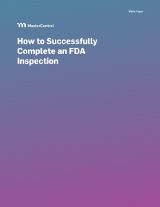
GxP Lifeline
10 Things to Know Before Writing an FDA 483 Response Letter
So, you’re a medical device manufacturer and you just got a Form 483 or warning letter from the U.S. Food and Drug Administration (FDA). Now what?
The FDA requires a response to most compliance notices within 15 business days, so the clock is ticking! Time is of the essence when crafting a response letter and remediation plan. Below are 10 things you should do ASAP.
#1 Start Preparing for Your FDA 483 Response Letter Immediately
Don’t ignore a warning letter. The remediation process is labor-intensive and time sensitive, so getting executive support and the right internal expertise is critical. Plus, it’s far easier to amass resources and prioritize next steps when you have executive backing. If you have trouble convincing senior management and other stakeholders of the importance of dealing with a warning letter or Form 483 remediation, point out the potential impact not responding could have on stock prices and brand equity, not to mention potential legal ramifications. Once you’ve caught their attention, assemble the remediation team. Choose leaders from each area pertinent to the observations listed in the FDA warning letter. This team will help the head of RA/QA oversee the response and keep management up to date on progress.
#2 Get Outside Remediation Help
Current internal expertise and resources may still not be enough to address the issue(s) laid out in the warning letter. Consider hiring a consultant who specializes in Form 483 remediation. Their outside perspective may resonate with management, and they can often use their reputation with the FDA to your advantage.
#3 Don’t Make Quality Compliance Assumptions
Don’t assume everyone in your company knows and uses the same best practices. That’s prone to get you a Form 483 in the first place. If something is touted as “common sense,” it’s probably not. Especially in regulated environments, like medical device manufacturing, complacency can lead to big problems. Quality and compliance must be documented in your operational strategy. Make your response SOPs and work instructions as clear and concise as possible and share them with the entire company.
#4 Be Brutally Honest About Nonconformance
Over time a company’s self-assessment and the FDA’s view of their performance can diverge. Even hard-working staff may justify or minimize potential vulnerabilities to get things done. A defensive attitude when confronted with a nonconformance won’t do you any favors. The FDA is interested in the corrective actions you intend to take to fix the situation that led to the warning letter or Form 483 — not justifications.
Your Form 483 response letter should be transparent and comprehensive, addressing not only the observation(s) but also the associated systemic issues. An antagonistic or incomplete response letter will likely inspire further scrutiny.
#5 Designate Department Roles in Your Form 483 Response Letter
Small business and startup employees often wear many hats. Regardless of company size, it’s important to provide the FDA with a list of key personnel and identify each person’s primary role(s) and responsibilities in your response.
#6 Divide and Conquer FDA Warning Letter Observations
Assign a key team member to lead the resolution of each observation. Hold regular response team meetings to monitor progress. Most one-off observations, such as poor operator performance, can be corrected with surveillance and training. Systemic observations, on the other hand, usually require larger process changes. These must be addressed in your response. However, a problem doesn’t need to demonstrate a trend to be critical. You can have a severe product issue — even if it is a one-time occurrence. It’s important to give equal attention to each case regardless of origin or scope.
#7 Don’t Speculate in Your FDA 483 Response Letter
Stick to the facts. Don’t speculate or volunteer information unless it can help relieve a potential observation. A tight capsule of solid data beats a truckload of conjecture. Speculation can be a major reason for escalation and enforcement action, so avoid it at all costs.
#8 Go Above and Beyond the Form 483
Often, Form 483s are the symptom of a much larger issue. You’re likely to unearth other potential compliance problems during the remediation process. By being proactive, you show the FDA you’re doing more than the minimum and are committed to continuous quality improvement and compliance.
#9 Address Timelines — But Be Realistic
A Form 483 remediation plan and response letter aren’t complete without progress milestones. Outline the short-term steps you intend to take toward resolution, as well as exact deadlines for completing corrective actions.
But be realistic. Give yourself time to correct the root cause with sustainable solutions rather than quick fixes. Show investigators you understand the consequences of the deviation. Explain each aspect of the resolution to provide a successful outcome and your company’s commitment to prevent reoccurrence. Demonstrate you’re not just remedying the problem for compliance, but by doing so you’re making your business better.
#10 Look for Trends That May Lead to Future FDA Warning Letters
Minimize your chance of receiving future Form 483s by keeping an eye out for red flags known to attract the FDA’s attention such as:
- Enduring internal quality issues..
- Repeated FDA inspections or observations.
- Failure to submit adverse event reports.
- A large number of customer complaints about the same issue, or several complaints about varying issues.
- No trending data or poor trend analysis.

